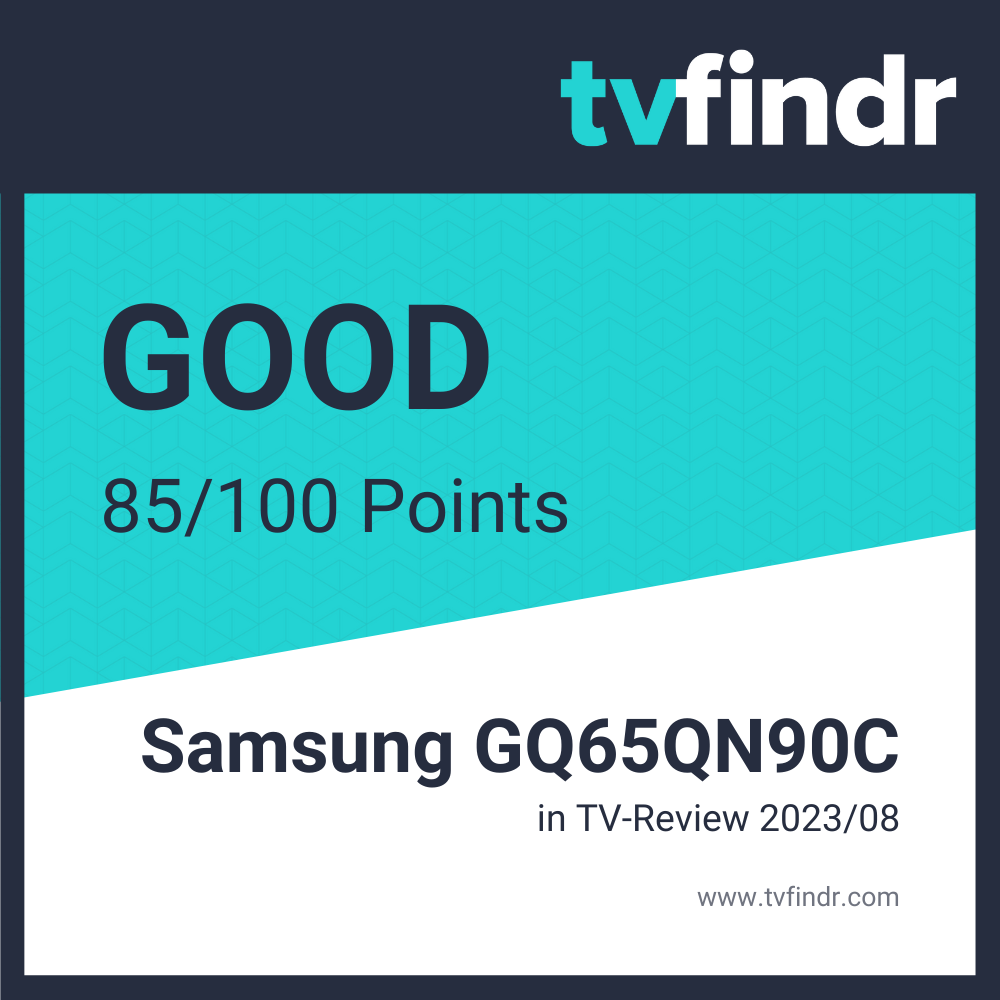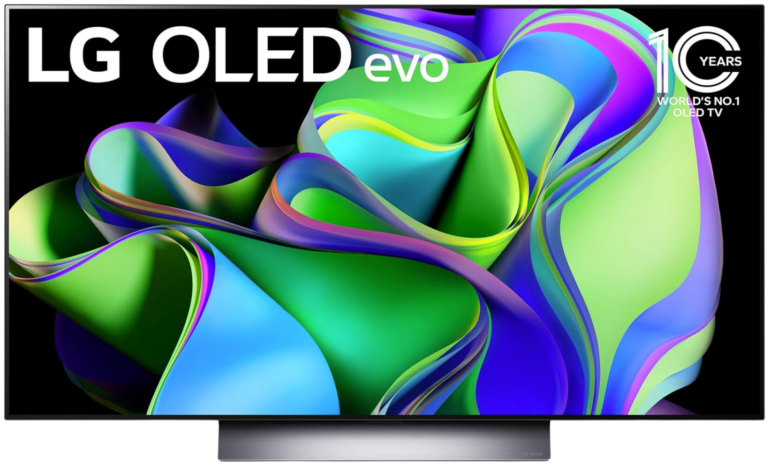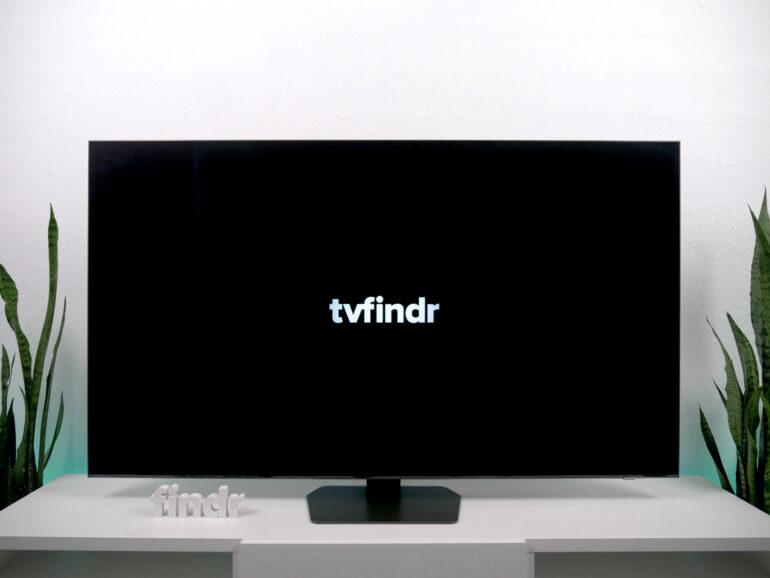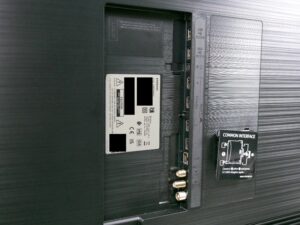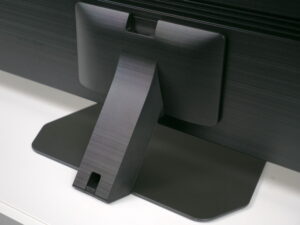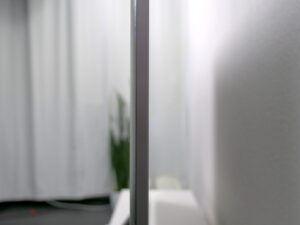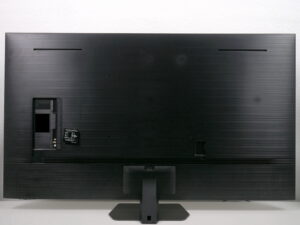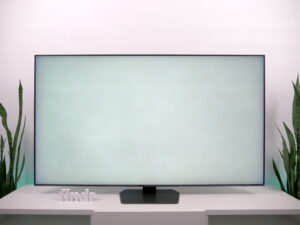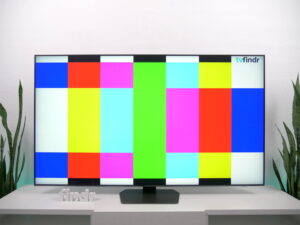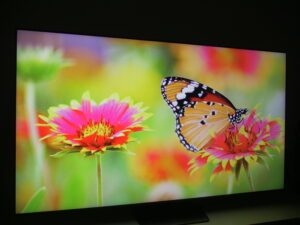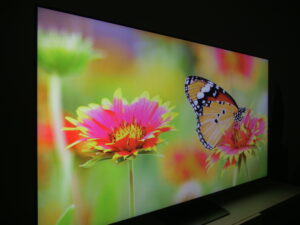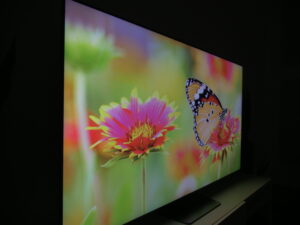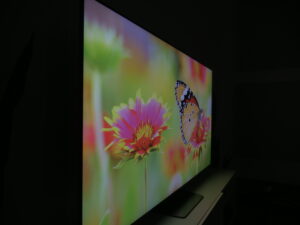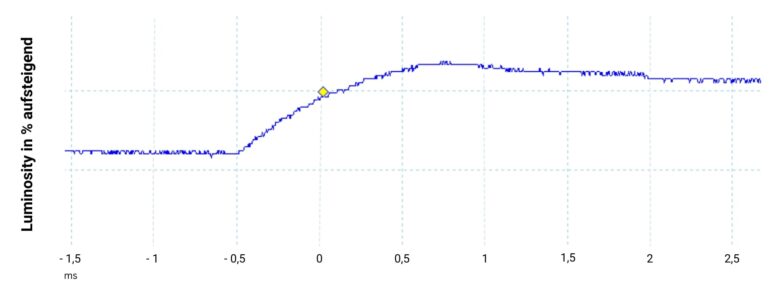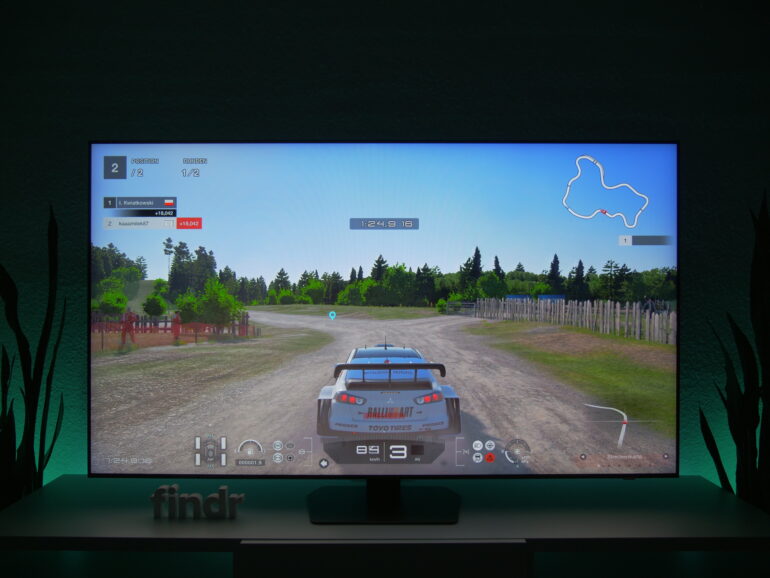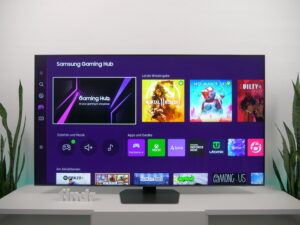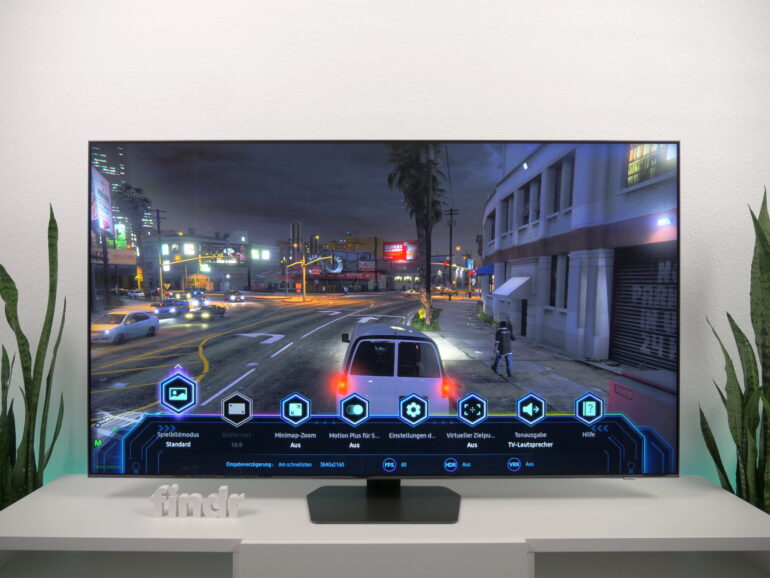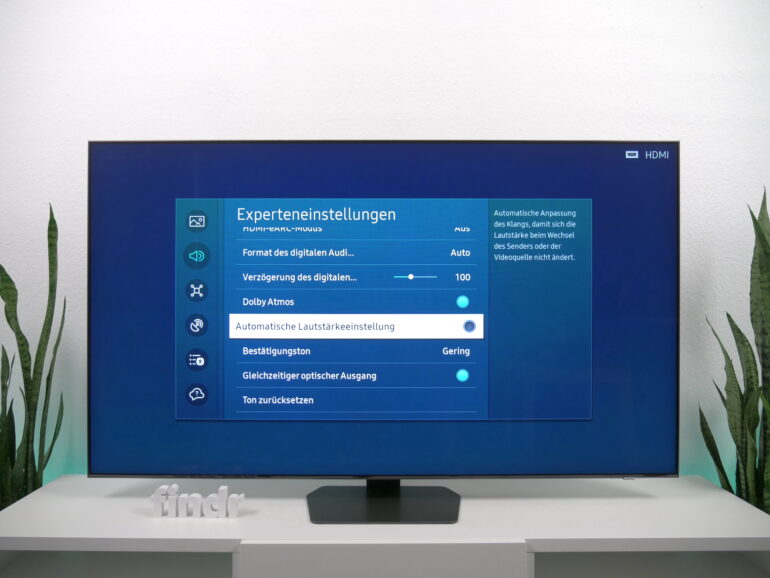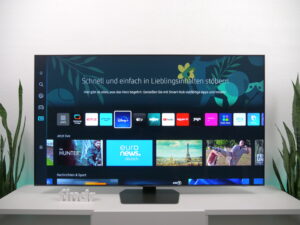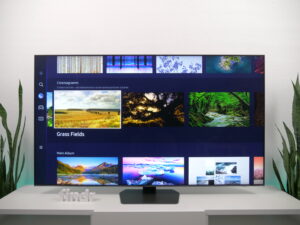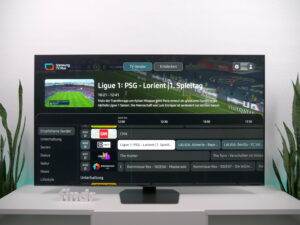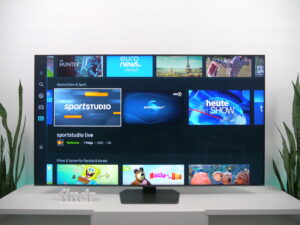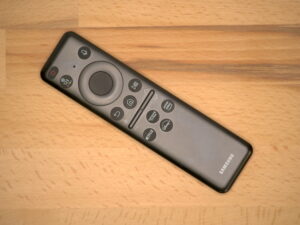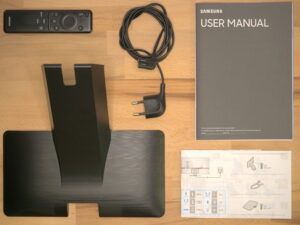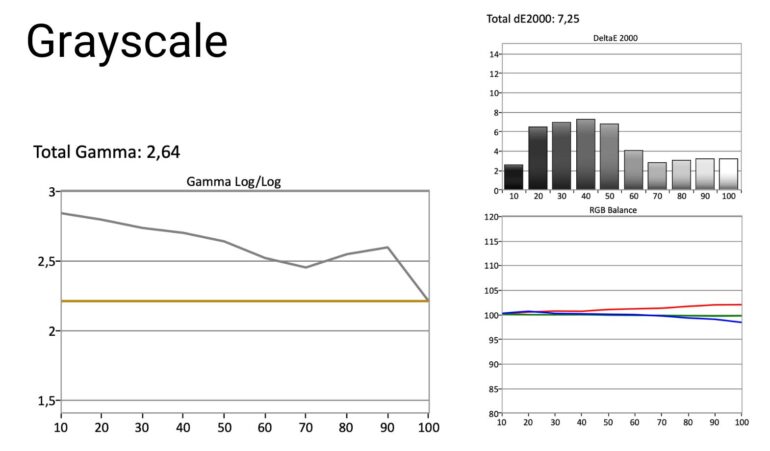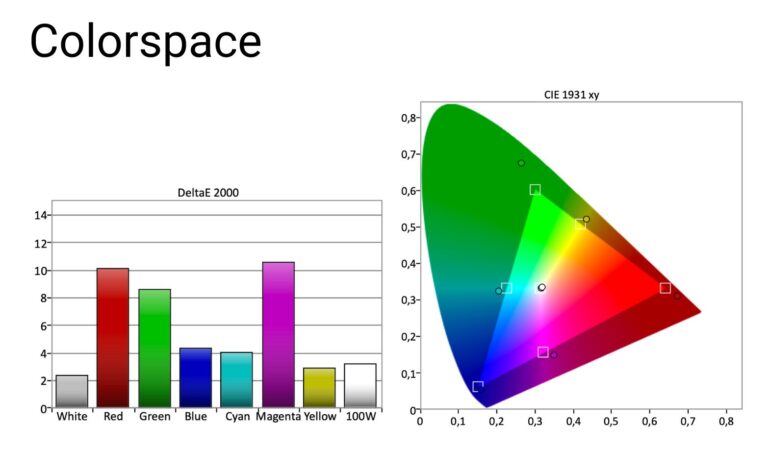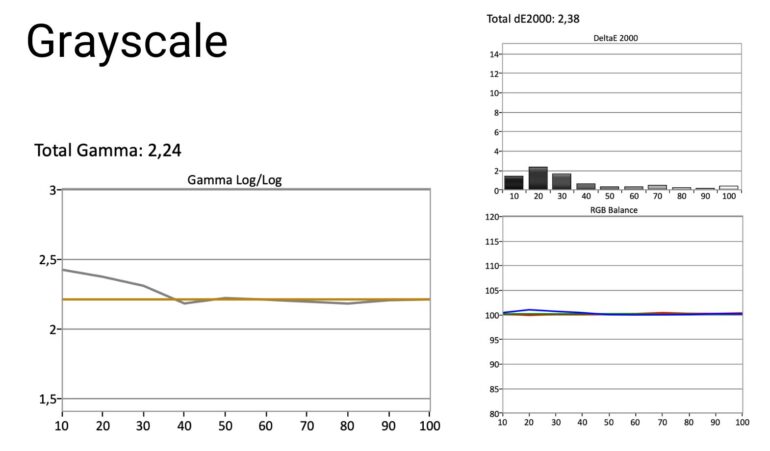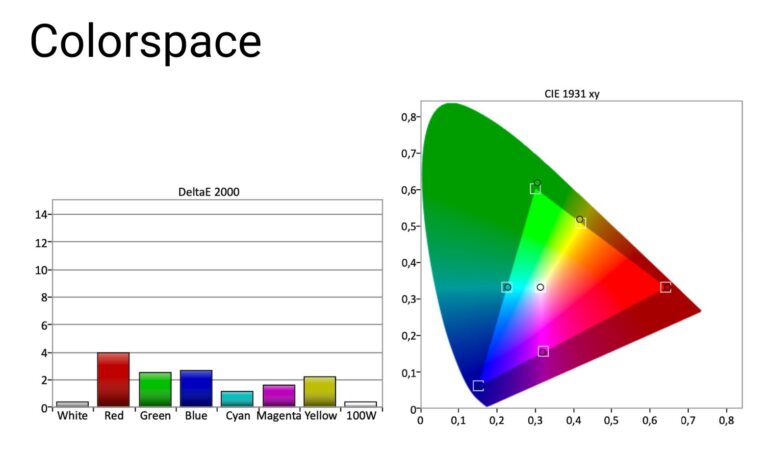Samsung Neo QLED QN90C Review & Rating

tvfindr Editorial
As a studied technology journalist Tobi likes to write regularly about the colorful world of TV sets & Co. Further interests: Music, cars, gaming, soccer
Samsung Neo QLED QN90C - Step-Down Option with strong Luminance
By choosing the Samsung Neo QLED QN90C, you get a backlit TV based on Mini-LED technology. The extremely high luminance makes this TV of the upper mid-range class an excellent choice for rooms flooded with light. With that we can place the model above its predecessor and just below the top model QN95B from 2022.
At the same time, the QN90C brings high coverage of the DCI-P3 colour space to the panel and reduces reflections on the screen particularly well. The precise dimming also minimises the overglow of bright contours on dark backgrounds. With regard to the change from VAVertical Alignment, type of LCD Panel in the previous version to ADS technology and the associated loss of the ultra-wide angle coating, the viewing stability is rather mediocre and therefore only suitable for moderate group sizes.
Despite the lack of Dolby Vision support, the device is next-gen capable and, together with its extensive features, a good choice for gamers who own an Xbox Series X|S or PlayStation 5. On top of that, the size range starts at 43 inches, which allows it to be set up in smaller rooms or used with a PC at home.
As usual, the audio performance is rather limited, but Dolby Atmos, an eARC port, Multiroom and Q-Symphony provide options that allow you to enhance the sound in many ways.
- Extremely good brightness values
- Handling reflections
- High colour space coverage
- Extensive gaming features
- Multiple Dolby Audio formats
- Wide range of sizes
- Processing on a proper level
- Powerless sound
- Viewing angle somewhat small
- No passthrough for DTS
- Foot construction wobbles a lot
Some options beside the Samsung Neo QLED QN90C
If you don’t want to miss out on the advantages of Mini-LEDs and OLED TVs restrict you too much in terms of usage, you can fall back on Sony’s flagship X95L, which is more precisely colour-coordinated. In addition to HDR10 and Dolby Vision, IMAX support is also offered here.
You already owned an OLED and can’t do without the excellent picture quality? Then the C3 with its extensive gaming equipment could be an update solution for you. If you want to save a bit of money and still aim for comparatively good brightness values, you can knock on the door of the slightly cheaper Samsung Neo QLED QN85C step-down model.
IMAX support: Sony X95L
Deepest Black: LG OLED evo C37
Cheaper: Samsung QN85C
Samsung Neo QLED QN90C: Lighter, but not a lightweight
Although the backlit Samsung Neo QLED QN90C has lost a few pounds compared to its predecessor, the model still belongs almost to the heavyweight category compared to some of its competitors. If you include the stand, it still weighs 27.5 kilograms at 65 inches. With a 55-inch screen, that is still just under 20 kilograms. The 75-inch version has a weight of 40 kilograms.
Installing the metal end plate including the plastic arm could have been a little quicker and without additional tools – as with the S90C or A80L, for example – but the eight screws on the bottom and back of the stand and the housing are anchored comparatively quickly and the Neo QLED is set up.
- Clean manufacturing
- Good cable routing
- Slightly lighter than the predecessor
- Wobbly foot construction
- No height adjustment
- Foot does not swivel
Wobbly business with the Samsung Neo QLED QN90C
However, the provided base does not necessarily help to give the said weight the necessary stability. What we clearly dislike here is the rather large scope for wobbling. Hardly a touch remains unpunished. Thus, the generally solid stand leaves us with a slight residual scepticism and conveys a material thickness that could easily be a little thicker at this point.
Otherwise, we can’t really complain about the workmanship. The panel is precisely framed in the case and has no curvature whatsoever. We couldn’t detect any noticeably large gaps or other irregularities either. Due to the backlighting, the TV cannot compete with the extremely thin — in some places almost too thin — OLEDs in terms of depth. The bezel is pleasantly slim and almost unnoticeable.
You can lead cables away cleanly
If you look at the TV straight on, the connections are on the right-hand side. However, you will not find an additional faceplate here. Instead, you get a cover that snaps onto the back of the base. Several cutouts in the housing are used to latch your connection cables. The foot acts as an additional passthrough option.
A small opening in the heel brings the cables back to the outside. Although the recesses vary in size, we could not fix everything properly. An additional, even wider option would be desirable at this point. You cannot rotate or adjust the height of the construction. If you use a soundbar that is placed directly below the QN90C, it might cover the lower edge of the screen.
Especially if you have little space at the front of your sideboard and are forced to position the TV on the top of the stand. As with all modern televisions, wall mounting is achieved using the VESA standard. In this case, with a hole spacing of 400 x 300 millimetres.
Get increased brightness with the Samsung Neo QLED QN90C
Backlit TVs like the Samsung Neo QLED QN90C are the best way to go if you have to deal with bright and very bright lighting conditions on-site. In this respect, the 2023 model is even better suited compared to the QN90B. That’s made possible by the higher luminance of the panel.
Both the peak brightness and the illumination across the entire surface have increased. This ensures that the Mini-LED can provide a sufficiently visible and high-contrast display even in daylight situations.
- Great brightness
- Proper colour gamut
- Little blooming
- No rainbow effect
- Limited viewing angle
- Without Dolby Vision
- No IMAX support
On top of that, the performance is now even close to the 2022 flagship QN95B. The reflection behaviour also benefits considerably from the higher luminance. In combination with the high-gloss coating, even direct LED sources are properly minimised.
An additional advantage: since Samsung has now replaced the previous VA panel with an ADS version, the so-called Ultra Wide Viewing Angle coating is no longer an option.
Therefore, the sometimes somewhat annoying rainbow effect on the screen surface is now also gone. The colour representation covers a large part of the DCI-P3 colour space.
However, the Samsung Neo QLED QN90C is not without certain compromises.
However, you will have to accept a few limitations in terms of display quality. With a look at our test device and the ability to display uniform colours over the entire screen, there is still some room for improvement.
In general, the colour homogeneity is comparatively good, but still does not come close to the fine reproduction of many OLED displays. Though there are no darker spots around the centre of the picture on our model, they appear more frequently in the corners of the screen – as it often happens with backlighting.
Although ADS and IPS displays offer a very good viewing angle, they also reach their performance limits when viewed at an angle.
If you move beyond an angle of about 30 degrees, you can expect the first losses in quality. Colours increasingly fade and the brightness decreases noticeably.
It is therefore better to avoid too much oblique viewing and, if possible, to ensure a moderately wide positioning if you are watching in a larger group. The omission of the above-mentioned additional coating to increase viewing angle stability also has its negative effect here.
Samsung Neo QLED QN90C with short response time but artefacts
When handling busy image content and slow scenes, the intermediate image calculation shows its best side. However, as soon as the pace picks up, the Samsung Neo QLED QN90C struggles to keep up and constantly leaves visible artefacts in the displayed material. In general, however, the screen has a pleasantly short response time.
- Reactive screen
- Judder smoothing
- Artefacts during busy scenes
- Flickering picture possible with BFI
Our internal measurement of the rise time to a light level of 80 percent yielded a result of about 3.5 milliseconds. This gives the TV an advantage when gaming or watching sports. If you want to further minimise motion blur, you can also activate the BFI function on an optional basis. This turns off the backlight for a fraction of a second and practically cuts off a small part of the content.
This creates a more clearly defined visual impression. Usually we advise people not to do this, because the brightness decreases and the viewer may perceive a flickering image. Responsive pixels also have a downside.
Typically, fast switching also means pre-programmed judder within low frame rate content. Thus, film and series material stutters at times, especially in slow scenes. If you are bothered by this, the above-mentioned function to calculate intermediate images will help.
However, do not set the intensity too high. If you do, the unpopular soap opera effect will almost inevitably appear. So feel your way to the setting that is most comfortable for you.
Samsung Neo QLED QN90C - Gaming TV on a Mini-LED basis
Apart from movies and television, you can also use the TV for other leisure activities, such as an extensive gaming session. For this, Samsung uses almost all the features that are available on the market in 2023 and therefore ensures that the current next-gen consoles also harmonise extremely well with the Samsung Neo QLED QN90C. As usual, the manufacturer continues to consistently avoid licensing Dolby Vision.
- Extensive equipment
- Features a game optimiser
- Cloud Gaming
- Available in many sizes
- No Dolby Vision Gaming
Xbox Series X|S owners will therefore not get a green tick in the TV details when it comes to Dolby Vision gaming. However, you can generally overlook this fact, as the Samsung Neo QLED QN90C delivers a really good HDR performance. Important elements such as the refresh rate, VRR or the picture mode are presented briefly and crisply within the game optimiser.
This gives you a compact and quick overview of the status for all important gaming functions. Four HDMI 2.1 ports with full bandwidth also provide enough options to plug in your platforms. In terms of input lag, the Mini-LED TV is roughly on par with the S90C from the QD-OLED series. This paves the way for short input times.
Cloud gaming as an additional option
If you don’t have a console at home or simply want to try out other gaming services, Samsung’s Gaming Hub offers many additional cloud gaming options such as GeForce Now or Amazon Luna. All you need is a compatible Bluetooth controller and a stable internet connection with at least 20 Mbps.
Of course, a corresponding subscription must not be missing either. As for the 144 hertz support from the QD series and the backlit top models QN95B and QN95C, the South Korean manufacturer has decided to do without this feature on the QN90C series. This feature will probably only be relevant for a few of you anyway.
In order to even use this option, you will need a powerful PC in any case. When it comes to the size selection, the model is positioned on a broad level. This allows potential buyers who are more interested in a smaller version to get what they are looking for.
Samsung Neo QLED QN90C with an expectedly mixed result
As with the vast majority of TVs, the QN90C cannot really surprise in the category of sound quality. Rumbling and booming are therefore not among the strengths of the 4.2.2-channel system with Object Tracking Sound Plus and a continuous output of 60 watts, which is already known from the predecessor. While the sound image is rather poor in the lower range, dialogues sound clear and are easily understandable. Even at higher volumes, the subjective sound impression remains good.
- Native audio via eARC
- Dual audio with Bluetooth
- Various Dolby formats
- Q-Symphony
- Hardly any bass frequencies
- Headphone output missing
Is the sound system therefore fully suitable for film and series lovers who value a good all-round carefree package? No, not really. Flat-screen TVs without an external audio solution are not designed to knock you off your feet and shake the room permanently. Therefore, we generally advise you to think about additional peripherals if you want to adequately complement the sound experience and a powerful bass reflex is important to you.
As usual, Dolby Atmos can be forwarded uncompressed to compatible soundbars or home cinema systems via the available eARC connection. A headphone output is missing, but you get dual audio support via Bluetooth. This way you can, for example, operate two headsets simultaneously with different volume or equaliser settings.
As with many other models, the Samsung Neo QLED QN90C also features the familiar Q-Symphony feature, which allows you to use the TV as a central speaker system, as long as you have a compatible sound bar. If necessary, you can use the Multiroom function via app to link your speakers in different areas of your home.
Samsung Neo QLED QN90C: Extensive feature package
Navigation through Samsung’s Tizen 8 operating system, which is not all that organised, is generally quite smooth. Main, sub and quick menus appear quickly after the first keystroke. Overall, we never get the feeling that the TV is overburdened with inputs. You can enter physical commands via the familiar and compact solar remote control. As usual, a microphone button provides voice navigation with Google Assistant or Samsung’s in-house solution Bixby.
- Wide app and streaming selection
- Fast navigation
- Compatible with AirPlay 2
- Remote control with solar cell
- Many accessibility functions
- Voice navigation via Google and Bixby
However, you cannot speak freely with the TV. Important points such as streaming services, the app offer or the cloud gaming options can be selected directly on the left side of the home screen. The gear button on the remote control gives you an overview of the basic settings. This is also how you get to the somewhat convoluted main menu.
If you hold down the button, a customisable overview opens. From there, you can also access the central menu structure via a gear icon in the right-hand corner.
In addition to Samsung TV Plus with numerous channels that you receive via streaming, there is also an Ambiente area. This allows you to display photo and video content of different themes in an endless loop.
Improved accessibility is provided, for example, by a mode for increased contrast, menu and text enlargement for clearer visibility or the so-called remote control learn function.
Each time you press a button on the control panel, the TV tells you the exact purpose of the button using a so-called voice guard.
HDR calibration
Our test device shows little precision before calibration
Despite deactivating various picture functions and adjusting the colour temperature to an intense warm white, the measured values of the Samsung Neo QLED QN90C do not really look good in the run-up to the calibration. Even the measurement of the grey levels shows deviations of more than 7 error points, especially in dark areas.
Compared to the reference, the difference between 20 and 50 percent luminosity is extremely big. As a result, dark colour tones are clearly displayed too brightly. This is also reflected in the gamma log value, which is noticeably too high.
The RGB balance is not really much better. The panel can initially maintain the relatively balanced mixture, but starting at a luminance value of 40 percent, it increasingly has problems with an red tint.
Towards the end, the balance of the colours is no longer given and a clear red cast is present in bright content. This observation is also evident in the colour representation of red and green. As a result, there is an inaccuracy of more than 10 points in the colour difference DeltaE for the mixed colour magenta as well.
Closer to the reference after calibration
Once the recalibration of the panel was completed and we sent the TV through our Calman software again, the results turned out to be much better.
Although the brightness levels at 10, 20 and 30 percent still show slight inconsistencies, the overall maximum error has shrunk from above 7 error points to just slightly more than 2. The gamma log also looks better now, although there is still an upward swing here.
The colour balance is now much more homogeneous and practically without any noticeable deflection. All brightness ranges are now covered with a much more balanced colour mixture of red, green and blue.
We were not able to completely eliminate the previously existing irregularities in the colour representation, but we could clearly minimise them. Only the maximum deviation of 4 error points for red is still a little too much.
Samsung Neo QLED QN90C Datasheet
43QN90C technical specifications
Dimensions
| Screen diagonal | 43 Inch |
|---|---|
| Dimensions without stand (WxHxD) | 961 x 559 x 27 mm |
| Weight without stand | 9,4 kg |
| Dimensions with stand (WxHxD) | 961 x 620 x 220 mm |
| Weight with stand | 13,4 kg |
| Footprint (WxD) | 519 x 220 mm |
| VESA Norm | 200 x 200 mm |
Image properties
| Panel type | VA Panel |
|---|---|
| Panel Manufacturer | N/A |
| Colour depth | 10 Bit |
| FRC | |
| Resolution | 4K |
| Contrast ratio | 83200 :1 |
| Color space coverage | 88 % |
| REC 2020 | 48 % |
| Average brightness | 1340 Nits |
| Maximum brightness | 1950 Nits |
| Backlighting | Mini LED |
| Local dimming | Full Array Local Dimming |
| Dimming Zones | N/A |
| Curved | |
| Improved viewing angle |
Motion Handling
| Response Time | < 6 ms |
|---|---|
| Input Lag | < 11 ms |
| Frequency | 144 Hz |
| VRR |
HDR
| HDR | |
|---|---|
| HDR10 | |
| HLG | |
| HDR10+ | |
| Dolby Vision | N/A |
Energy
| Energy consumption standby (W) | 0,5 W |
|---|---|
| Energy consumption SDR | 54 W |
| Energy efficiency clas SDR | G |
| Energy consumption HDR | 114 W |
| Energy efficiency clas HDR | G |
Smart TV
| Operating system | Tizen 7.0 |
|---|---|
| Bluetooth | |
| WLAN | |
| USB recording PVR | |
| Timeshift | |
| Picture-in-picture | |
| Tuner | Analog (NTSC/PAL/SECAM) DVB-T DVB-T2 DVB-C DVB-S DVB-S2 |
| Twin Tuner |
Audio
| Audio Channels | 2.0 |
|---|---|
| Power (W) | 20 W |
| Dolby Digital | |
| DTS | |
| Dolby Atmos | |
| Integrated soundbar |
Connections
| HDMI 2.0 | |
|---|---|
| HDMI 2.1 | 4 |
| HDMI ARC | |
| USB 2.0 | 2 |
| USB 3.0 | |
| Ethernet RJ45 | 1 |
| 3.5mm jack | |
| Digital optical | 1 |
| Satellite | 2 |
| Antenna | 1 |
| Ci+ 1.4 | 1 |
50QN90C technical specifications
Dimensions
| Screen diagonal | 50 Inch |
|---|---|
| Dimensions without stand (WxHxD) | 1114 x 644 x 27 mm |
| Weight without stand | 13,5 kg |
| Dimensions with stand (WxHxD) | 1114 x 705 x 220 mm |
| Weight with stand | 17,6 kg |
| Footprint (WxD) | 519 x 220 mm |
| VESA Norm | 200 x 200 mm |
Image properties
| Panel type | VA Panel |
|---|---|
| Panel Manufacturer | N/A |
| Colour depth | 10 Bit |
| FRC | |
| Resolution | 4K |
| Contrast ratio | 83200 :1 |
| Color space coverage | 88 % |
| REC 2020 | 48 % |
| Average brightness | 940 Nits |
| Maximum brightness | 1950 Nits |
| Backlighting | Mini LED |
| Local dimming | Full Array Local Dimming |
| Dimming Zones | N/A |
| Curved | |
| Improved viewing angle |
Motion Handling
| Response Time | < 6 ms |
|---|---|
| Input Lag | < 11 ms |
| Frequency | 144 Hz |
| VRR |
HDR
| HDR | |
|---|---|
| HDR10 | |
| HLG | |
| HDR10+ | |
| Dolby Vision | N/A |
Energy
| Energy consumption standby (W) | 0,5 W |
|---|---|
| Energy consumption SDR | 65 W |
| Energy efficiency clas SDR | F |
| Energy consumption HDR | 131 W |
| Energy efficiency clas HDR | G |
Smart TV
| Operating system | Tizen 7.0 |
|---|---|
| Bluetooth | |
| WLAN | |
| USB recording PVR | |
| Timeshift | |
| Picture-in-picture | |
| Tuner | Analog (NTSC/PAL/SECAM) DVB-T DVB-T2 DVB-C DVB-S DVB-S2 |
| Twin Tuner |
Audio
| Audio Channels | 2.2 |
|---|---|
| Power (W) | 40 W |
| Dolby Digital | |
| DTS | |
| Dolby Atmos | |
| Integrated soundbar |
Connections
| HDMI 2.0 | |
|---|---|
| HDMI 2.1 | 4 |
| HDMI ARC | |
| USB 2.0 | 2 |
| USB 3.0 | |
| Ethernet RJ45 | 1 |
| 3.5mm jack | |
| Digital optical | 1 |
| Satellite | 2 |
| Antenna | 1 |
| Ci+ 1.4 | 1 |
55QN90C technical specifications
Dimensions
| Screen diagonal | 55 Inch |
|---|---|
| Dimensions without stand (WxHxD) | 1227 x 706 x 26 mm |
| Weight without stand | 17,7 kg |
| Dimensions with stand (WxHxD) | 1227 x 768 x 237 mm |
| Weight with stand | 20,6 kg |
| Footprint (WxD) | 388 x 237 mm |
| VESA Norm | 200 x 200 mm |
Image properties
| Panel type | ADS Panel |
|---|---|
| Panel Manufacturer | N/A |
| Colour depth | 10 Bit |
| FRC | |
| Resolution | 4K |
| Contrast ratio | 83200 :1 |
| Color space coverage | 88 % |
| REC 2020 | 48 % |
| Average brightness | 940 Nits |
| Maximum brightness | 1950 Nits |
| Backlighting | Mini LED |
| Local dimming | Full Array Local Dimming |
| Dimming Zones | N/A |
| Curved | |
| Improved viewing angle |
Motion Handling
| Response Time | < 6 ms |
|---|---|
| Input Lag | < 11 ms |
| Frequency | 120 Hz |
| VRR |
HDR
| HDR | |
|---|---|
| HDR10 | |
| HLG | |
| HDR10+ | |
| Dolby Vision | N/A |
Energy
| Energy consumption standby (W) | 0,5 W |
|---|---|
| Energy consumption SDR | 81 W |
| Energy efficiency clas SDR | G |
| Energy consumption HDR | 184 W |
| Energy efficiency clas HDR | G |
Smart TV
| Operating system | Tizen 7.0 |
|---|---|
| Bluetooth | |
| WLAN | |
| USB recording PVR | |
| Timeshift | |
| Picture-in-picture | |
| Tuner | Analog (NTSC/PAL/SECAM) DVB-T DVB-T2 DVB-C DVB-S DVB-S2 |
| Twin Tuner |
Audio
| Audio Channels | 4.2.2 |
|---|---|
| Power (W) | 60 W |
| Dolby Digital | |
| DTS | |
| Dolby Atmos | |
| Integrated soundbar |
Connections
| HDMI 2.0 | |
|---|---|
| HDMI 2.1 | 4 |
| HDMI ARC | |
| USB 2.0 | 2 |
| USB 3.0 | |
| Ethernet RJ45 | 1 |
| 3.5mm jack | |
| Digital optical | 1 |
| Satellite | 2 |
| Antenna | 1 |
| Ci+ 1.4 | 1 |
65QN90C technical specifications
Dimensions
| Screen diagonal | 65 Inch |
|---|---|
| Dimensions without stand (WxHxD) | 1446 x 829 x 26 mm |
| Weight without stand | 24,2 kg |
| Dimensions with stand (WxHxD) | 1446 x 891 x 271 mm |
| Weight with stand | 27,5 kg |
| Footprint (WxD) | 390 x 271 mm |
| VESA Norm | 400 x 300 mm |
Image properties
| Panel type | ADS Panel |
|---|---|
| Panel Manufacturer | N/A |
| Colour depth | 10 Bit |
| FRC | |
| Resolution | 4K |
| Contrast ratio | 83200 :1 |
| Color space coverage | 88 % |
| REC 2020 | 48 % |
| Average brightness | 940 Nits |
| Maximum brightness | 1950 Nits |
| Backlighting | Mini LED |
| Local dimming | Full Array Local Dimming |
| Dimming Zones | 720 |
| Curved | |
| Improved viewing angle |
Motion Handling
| Response Time | < 6 ms |
|---|---|
| Input Lag | < 11 ms |
| Frequency | 120 Hz |
| VRR |
HDR
| HDR | |
|---|---|
| HDR10 | |
| HLG | |
| HDR10+ | |
| Dolby Vision | N/A |
Energy
| Energy consumption standby (W) | 0,5 W |
|---|---|
| Energy consumption SDR | 95 W |
| Energy efficiency clas SDR | F |
| Energy consumption HDR | 190 W |
| Energy efficiency clas HDR | G |
Smart TV
| Operating system | Tizen 7.0 |
|---|---|
| Bluetooth | |
| WLAN | |
| USB recording PVR | |
| Timeshift | |
| Picture-in-picture | |
| Tuner | Analog (NTSC/PAL/SECAM) DVB-T DVB-T2 DVB-C DVB-S DVB-S2 |
| Twin Tuner |
Audio
| Audio Channels | 4.2.2 |
|---|---|
| Power (W) | 60 W |
| Dolby Digital | |
| DTS | |
| Dolby Atmos | |
| Integrated soundbar |
Connections
| HDMI 2.0 | |
|---|---|
| HDMI 2.1 | 4 |
| HDMI ARC | |
| USB 2.0 | 2 |
| USB 3.0 | |
| Ethernet RJ45 | 1 |
| 3.5mm jack | |
| Digital optical | 1 |
| Satellite | 2 |
| Antenna | 1 |
| Ci+ 1.4 | 1 |
75QN90C technical specifications
Dimensions
| Screen diagonal | 75 Inch |
|---|---|
| Dimensions without stand (WxHxD) | 1670 x 957 x 27 mm |
| Weight without stand | 34,1 kg |
| Dimensions with stand (WxHxD) | 1670 x 1017 x 301 mm |
| Weight with stand | 39,7 kg |
| Footprint (WxD) | 417 x 301 mm |
| VESA Norm | 400 x 400 mm |
Image properties
| Panel type | ADS Panel |
|---|---|
| Panel Manufacturer | N/A |
| Colour depth | 10 Bit |
| FRC | |
| Resolution | 4K |
| Contrast ratio | 83200 :1 |
| Color space coverage | 88 % |
| REC 2020 | 48 % |
| Average brightness | 940 Nits |
| Maximum brightness | 1950 Nits |
| Backlighting | Mini LED |
| Local dimming | Full Array Local Dimming |
| Dimming Zones | N/A |
| Curved | |
| Improved viewing angle |
Motion Handling
| Response Time | < 6 ms |
|---|---|
| Input Lag | < 11 ms |
| Frequency | 120 Hz |
| VRR |
HDR
| HDR | |
|---|---|
| HDR10 | |
| HLG | |
| HDR10+ | |
| Dolby Vision | N/A |
Energy
| Energy consumption standby (W) | 0,5 W |
|---|---|
| Energy consumption SDR | 115 W |
| Energy efficiency clas SDR | F |
| Energy consumption HDR | 248 W |
| Energy efficiency clas HDR | G |
Smart TV
| Operating system | Tizen 7.0 |
|---|---|
| Bluetooth | |
| WLAN | |
| USB recording PVR | |
| Timeshift | |
| Picture-in-picture | |
| Tuner | Analog (NTSC/PAL/SECAM) DVB-T DVB-T2 DVB-C DVB-S DVB-S2 |
| Twin Tuner |
Audio
| Audio Channels | 4.2.2 |
|---|---|
| Power (W) | 60 W |
| Dolby Digital | |
| DTS | |
| Dolby Atmos | |
| Integrated soundbar |
Connections
| HDMI 2.0 | |
|---|---|
| HDMI 2.1 | 4 |
| HDMI ARC | |
| USB 2.0 | 2 |
| USB 3.0 | |
| Ethernet RJ45 | 1 |
| 3.5mm jack | |
| Digital optical | 1 |
| Satellite | 2 |
| Antenna | 1 |
| Ci+ 1.4 | 1 |
85QN90C technical specifications
Dimensions
| Screen diagonal | 85 Inch |
|---|---|
| Dimensions without stand (WxHxD) | 1892 x 1082 x 27 mm |
| Weight without stand | 43,5 kg |
| Dimensions with stand (WxHxD) | 1892 x 1143 x 321 mm |
| Weight with stand | 49,9 kg |
| Footprint (WxD) | 418 x 321 mm |
| VESA Norm | 600 x 400 mm |
Image properties
| Panel type | ADS Panel |
|---|---|
| Panel Manufacturer | N/A |
| Colour depth | 10 Bit |
| FRC | |
| Resolution | 4K |
| Contrast ratio | 83200 :1 |
| Color space coverage | 88 % |
| REC 2020 | 48 % |
| Average brightness | 940 Nits |
| Maximum brightness | 1950 Nits |
| Backlighting | Mini LED |
| Local dimming | Full Array Local Dimming |
| Dimming Zones | N/A |
| Curved | |
| Improved viewing angle |
Motion Handling
| Response Time | < 6 ms |
|---|---|
| Input Lag | < 11 ms |
| Frequency | 120 Hz |
| VRR |
HDR
| HDR | |
|---|---|
| HDR10 | |
| HLG | |
| HDR10+ | |
| Dolby Vision | N/A |
Energy
| Energy consumption standby (W) | 0,5 W |
|---|---|
| Energy consumption SDR | 133 W |
| Energy efficiency clas SDR | F |
| Energy consumption HDR | 339 W |
| Energy efficiency clas HDR | G |
Smart TV
| Operating system | Tizen 7.0 |
|---|---|
| Bluetooth | |
| WLAN | |
| USB recording PVR | |
| Timeshift | |
| Picture-in-picture | |
| Tuner | Analog (NTSC/PAL/SECAM) DVB-T DVB-T2 DVB-C DVB-S DVB-S2 |
| Twin Tuner |
Audio
| Audio Channels | 4.2.2 |
|---|---|
| Power (W) | 60 W |
| Dolby Digital | |
| DTS | |
| Dolby Atmos | |
| Integrated soundbar |
Connections
| HDMI 2.0 | |
|---|---|
| HDMI 2.1 | 4 |
| HDMI ARC | |
| USB 2.0 | 2 |
| USB 3.0 | |
| Ethernet RJ45 | 1 |
| 3.5mm jack | |
| Digital optical | 1 |
| Satellite | 2 |
| Antenna | 1 |
| Ci+ 1.4 | 1 |
Frequently asked questions about the Samsung Neo QLED QN95C
What does Mini LED TV mean?
Nowadays, LED-LCD televisions have an extensive range of specifications. One important point here is the type of illumination. If a TV device has so-called Mini-LEDs, the backlighting is equipped with numerous tiny light-emitting diodes. This ensures a finer distribution of brightness, especially in dark areas of the picture, and generally increases the contrast performance of the device.
What are the disadvantages of screens with mini-LEDs?
Despite increased precision, displays with Mini-LED technology are not free from a subtle shimmer around bright objects. Although this effect is often not particularly pronounced, OLED technology nevertheless delivers a better result in this respect. The same applies to the uniformity of large colour areas. Here, too, corresponding screens cannot quite keep up – due to darker corner areas or slight spot islands. An additional point might be the viewing angles characteristics.
Which Mini LED TV is the best one?
Today, there are quite a few TV devices with this technology on the market. Among the most powerful in terms of brightness are the Neo QLED devices made by Samsung. When it comes to colour representation, top models of Sony or Panasonic can come out on top as well.
Which technology is better: OLED or Mini-LED
In general, the answer to this question depends on the illumination. Bright rooms and window fronts that are located in an unfavourable position towards the TV screen – for example, right in your back – are only suitable for OLED models if you can at least dim the room noticeably. If you use the TV regularly in daylight, you will almost not be able to avoid powerful LED screens.
Samsung Neo QLED QN90C Connections
The 65QN90C has 4 HDMI 2.1 inputs, an HDMI eARC, 2 USB 2.0 ports, a digital optical TOSLINK output and a Twin Tuner. and just a Single Tuner.
Samsung Neo QLED QN90C Dimensions
The Samsung Neo QLED QN90C is dimensioned without stand as follows (WxHxD):
- 43 Inch: 961 x 559 x 27 mm
- 50 Inch: 1114 x 644 x 27 mm
- 55 Inch: 1227 x 706 x 26 mm
- 65 Inch: 1446 x 829 x 26 mm
- 75 Inch: 1670 x 957 x 27 mm
- 85 Inch: 1892 x 1082 x 27 mm
Samsung Neo QLED QN90C Wall Mounting
The Samsung Neo QLED QN90C is compatible with the following wall mounts:
- 43 Inch:
200 x 200 mmFlat Pivotable
- 50 Inch:
200 x 200 mmFlat Pivotable
- 55 Inch:
200 x 200 mmFlat Pivotable
- 65 Inch:
400 x 300 mmFlat Pivotable
- 75 Inch:
400 x 400 mmFlat Pivotable
- 85 Inch:
600 x 400 mmFlat Pivotable
